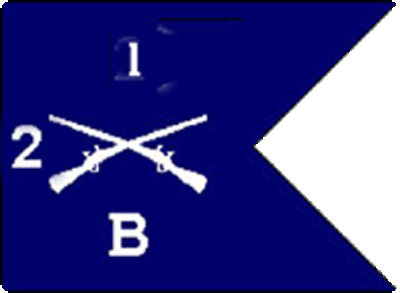

The various medals awarded during combat operations reflect specific degrees of unit and/or an individual soldier's performance.
Medal of Honor
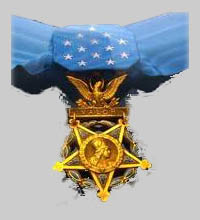
The Medal of Honor is the highest military decoration awarded by the United States government. It is bestowed by the United States Congress on members of the United States Armed Forces who distinguish themselves "conspicuously by gallantry and intrepidity at the risk of his or her life above and beyond the call of duty while engaged in an action against an enemy of the United States." Due to the nature of its criteria, it is often awarded posthumously (more than half have been since 1941). Members of all branches of the armed forces are eligible to receive the medal, and there are three versions, one for the Army (shown here), one for the Air Force, and one for the Navy, Marine Corps and Coast Guard. The Medal of Honor is bestowed upon an individual by the passing of a Joint Resolution in the Congress; and is then personally presented to the recipient or, in the case of posthumous awards, to next of kin, by the President of the United States, on behalf of the Congress, representing and recognizing the gratitude of the American people as a whole. Due to its honored status, the medal is afforded special protection under U.S. law. The Medal of Honor is one of two military neck order awards issued by the United States and is the sole neck order awarded to members of the armed forces. (The Commander's Degree of the Legion of Merit is also a neck order but it is only authorized for issue to foreign dignitaries). As the award citation includes the phrase "in the name of Congress", it is sometimes erroneously called the Congressional Medal of Honor; however, the official title is simply the Medal of Honor
Distinguished Service Cross
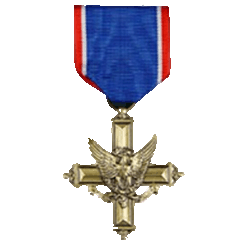
The Distinguished Service Cross (DSC) is the second highest military decoration that can be awarded to a member of the United States Army, for extreme gallantry and risk of life in actual combat with an armed enemy force. Actions that merit the Distinguished Service Cross must be of such a high degree to be above those required for all other U.S. combat decorations but not meeting the criteria for the Medal of Honor. The Distinguished Service Cross is equivalent to the Navy Cross (Navy, Marine Corps, and Coast Guard) and the Air Force Cross. The Distinguished Service Cross is awarded to a person who, while serving in any capacity with the United States Army, distinguishes himself or herself by extraordinary heroism not justifying the award of a Medal of Honor; while engaged in an action against an enemy of the United States; while engaged in military operations involving conflict with an opposing/foreign force; or while serving with friendly foreign forces engaged in an armed conflict against an opposing armed force in which the United States is not a belligerent party. The act or acts of heroism must have been so notable and have involved risk of life so extraordinary as to set the individual apart from his or her comrades. The Distinguished Service Cross was first awarded during World War I. In addition, a number of awards were made for actions before World War I. In many cases, these were to soldiers who had received a Certificate of Merit for gallantry which, at the time, was the only other honor besides the Medal of Honor the army could award. Others were belated recognition of actions in the Philippines, on the Mexican border and during the "Boxer Rebellion" in China. This decoration is distinct from the Distinguished Service Medal, which is awarded to persons in recognition of exceptionally meritorious service to the government of the United States in a duty of great responsibility.
Silver Star
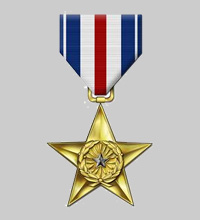
The Silver Star is the third-highest military decoration that can be awarded to a member of any branch of the United States armed forces for valor in the face of the enemy.
The Silver Star is awarded for gallantry in action against an enemy of the United States not justifying one of the two higher awards - the service crosses (Distinguished Service Cross, the Navy Cross, or the Air Force Cross), the second-highest military decoration, or the Medal of Honor, the highest decoration. The Silver Star may be awarded to any person who, while serving in any capacity with the armed forces, distinguishes himself or herself by extraordinary heroism involving one of the following:
1. In action against an enemy of the United States.
2. While engaged in military operations involving conflict with an opposing foreign force.
3. While serving with friendly foreign forces engaged in
armed conflict against an opposing armed force in which the United States is not a belligerent part.
Bronze Star
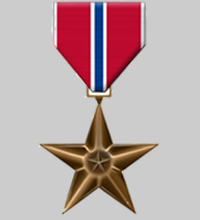
The Bronze Star Medal (or BSM) is a United States Armed Forces individual military decoration that may be awarded for bravery, acts of merit, or meritorious service. When awarded for bravery, it is the fourth-highest combat award of the U.S. Armed Forces and the ninth highest military award (including both combat and non-combat awards) in the order of precedence of U.S. military decorations. Officers from the other federal uniformed services are also eligible to receive the award if they are militarized or detailed to serve with a service branch of the armed forces.
Vietnam Cross of Gallantry
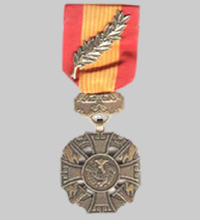
The Vietnam Gallantry Cross was a military decoration of South Vietnam which was established in August 1950. Also known as the Vietnamese Cross of Gallantry, the Gallantry Cross was awarded to any military personnel who have accomplished deeds of valor or displayed heroic conduct while fighting an enemy force. It was modeled after the French Croix de guerre. The Gallantry Cross was issued in four degrees, with a basic medal followed by higher degrees which were the equivalent of personal citations on an organizational level. The degrees of the Gallantry Cross were as follows: Gallantry Cross with Palm (Individual Award), Gallantry Cross with Gold Star (Corps citation), Gallantry Cross with Silver Star (Division citation), and Gallantry Cross with Bronze Star (Regiment or Brigade citation).
The United tates military began authorizing the Vietnam Gallantry Cross in March 1968 with retroactive presentation of the decoration to 1961. In 1974, Army General Order Number 8 authorized the Vietnam Gallantry Cross Unit Citation to every military unit of the United States Army which had served under the Military Assistance Command from 1961 to 1974. This effectively granted the unit version of the award to any member of the U.S.Army who had served for any period of time in the Republic of Vietnam. The unit was awarded the Republic of Vietnam Cross of Gallantry with Palm, streamer embroidered VIETNAM 1969; and Republic of Vietnam Cross of Gallantry with Palm, streamer embroidered VIETNAM 1971.
Vietnam Campaign Medal
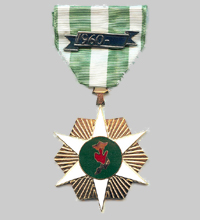
The Vietnam Campaign Medal is a military recognition awarded by the Republic of Vietnam to any member of the United States, Australian, New Zealand and allied military forces serving six months or more in support of Republic of Vietnam military operations. It may also be awarded to any service member who, while serving outside the geographical limits of the Republic of Vietnam, provided direct combat support to the Republic of Vietnam Armed Forces for a period exceeding six months. This stipulation most often applies to Vietnam War support from Thailand and Japan. In such cases, a US service member must have been awarded either the Vietnam Service Medal or the Armed Forces Expeditionary Medal to be eligible for the Vietnam Campaign Medal. For persons wounded by an enemy force, captured by the enemy in the line of duty, or killed in action, the Vietnam Campaign Medal is automatically awarded regardless of total time served in Vietnam. The Vietnam Campaign Medal is issued with a device known as the “1960 Bar”. The bar displays the date of 1960 followed by a dash and a blank space. The unusual appearance was caused by the government of the Republic of Vietnam stating that the 1960 bar would show the dates of the Vietnam War from start to finish, with the ending date placed on the 1960 bar after the South Vietnamese had triumphed over North Vietnam. Since South Vietnam fell, and the government ceased to exist, an ending date for the 1960 Bar was never established.
Vietnam Service Medal
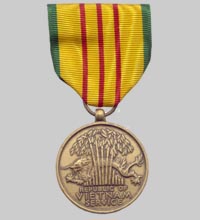
The Vietnam Service Medal is issued to recognize military service during the Vietnam War and is authorized to service members in every branch of the U.S. Armed Forces, provided they served on temporary duty for more than thirty consecutive days, or 60 non-consecutive days, attached to or regularly serving for one, or more, days with an organization participating in or directly supporting military ground operations or attached to or regularly serving for one, or more, days aboard a naval vessel directly supporting military operations in the Republic of Vietnam, Thailand, Cambodia, and/or Laos within the DoD defined combat zone between the dates of 15 November 1961 to 28 March 1973, and from 29 April 1975 to 30 April 1975. For those service members who supported Vietnam Operations from another country within Southeast Asia, DoD maintains (proximity to threat) as the disqualifying factor for Vietnam Service Medal eligibility.
Combat Infantryman Badge

The Combat Infantryman Badge (CIB) is the U.S. Army combat service recognition decoration awarded to soldiers—enlisted men and officers (commissioned and warrant) holding colonel rank or below, who personally fought in active ground combat while an assigned member of either an infantry or a Special Forces unit, of brigade size or smaller, any time after 6 December 1941. The CIB and its non-combat analogue, the infantry skill-recognition Expert Infantryman Badge (EIB) were simultaneously created during World War II as primary recognition of the combat service and sacrifices of the infantrymen who would likely be wounded or killed in numbers disproportionate to those of soldiers from the Army’s other service branches.
Combat Medical Badge
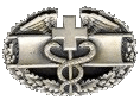
The Combat Medical Badge (CMB) was initiated on March 1, 1945. The Combat Medical Badge could specifically be awarded to officers and enlisted personnel of the Medical Department who were assigned or attached to an infantry unit. The CMB was to recognize medical aidmen who shared the same hazards and hardships of ground combat troops on a daily basis. The CMB was never intended to be awarded to all medical personnel and, due to the uniqueness of ground combat in the infantry, it is to be awarded only to those medics who served under direct fire with an infantry unit. To be awarded the Combat Medical Badge, the infantry unit to which the medical personnel were assigned or attached, must have engaged the enemy in active ground combat. Medical personnel must have been personally present and under fire in order to be eligible for this award. During the Vietnam War, the requirements were so stringent that recommending officers were required to document the location (in six digit co-ordinates), the time, the type of engagement, and also the intensity of fire to which the medical personnel were exposed. The Combat Medical Badge could also be awarded to U.S. Navy and U.S. Air Force medical personnel as long as they met the same requirements as Army medical personnel. New Army regulations, in May, 2004, added additional units besides Infantry where medics may qualify for the CMB.
Purple Heart
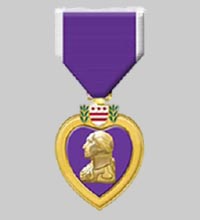
The Purple Heart is a United States military decoration awarded in the name of the President to those who have been wounded or killed while serving on or after April 5, 1917 with the U.S. military. The National Purple Heart Hall of Honor is located in New Windsor, New York. With its forerunner, the Badge of Military Merit, which took the form of a heart made of purple cloth, the Purple Heart is the oldest award that is still given to members of the U.S. military, the only earlier award being the obsolete Fidelity Medallion.
| Go to Awards Page 2 | Return to Awards Page | Return to Main Page |